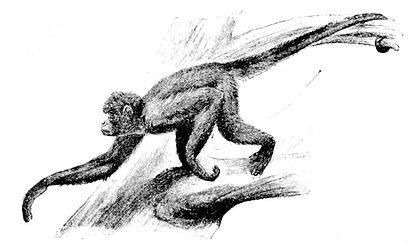the most typically arboreal of American monkeys. The use of the prehensile tail can frequently be studied in living examples in the Zoological Society's Gardens. With this "fifth hand" the Monkey feels for a place to grasp, and securely twists its tail round, moving it with the greatest ease from point to point. When the tail is being thus used it is carried erect over the head. The fact that this genus possesses no functional thumb is thought to be associated with the extreme perfection of its adaptability to an exclusively arboreal life. The hand without a thumb can act as an equally efficient hook for suspending the body; and what is useless in nature tends to disappear. These Monkeys have a wide range, extending from Mexico in the north to Uruguay in the south. There are ten species. The flesh of many Monkeys is eaten not only by natives but by Europeans; but the Spider Monkeys are said to furnish the most sapid food of all.

Fig. 265.—Spider Monkey. Ateles ater. × 1⁄12.
The Howling Monkeys, genus Mycetes, have also received the appropriate generic names of Alouatta and Stentor. The former of these two names, indeed, is that which should properly be applied to the genus. But Mycetes is perhaps better known. The "howling" is produced by saccular diverticula of the larynx, larger than those of other American Monkeys, such as Ateles, where, however, they are also developed. The hyoid bones, too,
